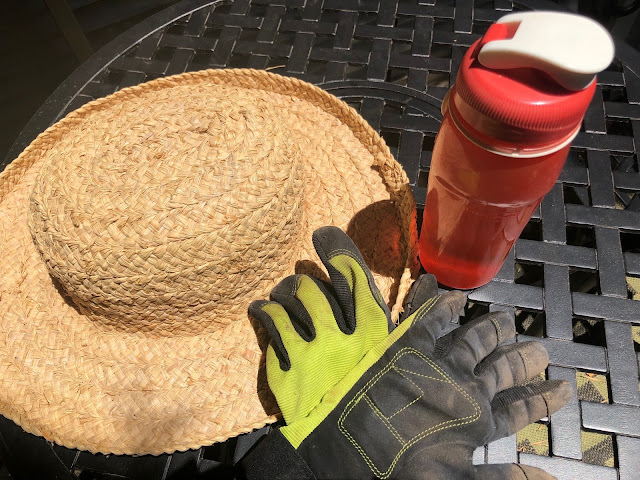
Take master gardeners' advice to protect against heat-related illnesses
 |
|
Heat can make you sick! Take precautions -- like wearing a hat
and having plenty of water nearby -- when gardening. (Photo: Kathy Morrison) |
A little sweat is one thing; heat exhaustion (or worse) can send you to the hospital.
Heat represents a real danger to gardeners. That’s important to remember during this string of triple-digit days.
When there’s work to be done, we’re tempted to tough it out and ignore our body’s warning signs. That’s a bad idea. According to the Centers for Disease Control and Prevention, an average of 658 Americans die each year due to extreme heat – despite the fact that all those deaths and illnesses are preventable.
As part of its master gardener training, the UC Cooperative Extension came up with these reminders and tips. They’re helpful to review before going out in this heat.
What are common heat illness disorders and symptoms?
1. Heat Stroke: Sweating stops and the body fails to regulate its temperature. Victims may die if they don’t receive immediate medical treatment. Characterized by: mental confusion, fainting, or seizures; hot dry skin usually reddish in color; and high body temperature.
Treatment: Call 911 immediately, soak victim’s clothing with cool water, move victim to shaded and cool area, fan victim to increase cooling of their body.
2. Heat Exhaustion: Profuse sweating results in dehydration. Characterized by: fatigue, dizziness and nausea; pale and moist skin; and possibly slightly elevated temperature.
Treatment: Have victim rest in shaded and cool place and drink fluids. Do not serve caffeinated fluids such as soft drinks, iced tea, or coffee.
3. Heat Cramps: Cramping thought to be due to loss of salt through sweating. Characterized by muscle spasms in arms, legs and abdomen during or following physical activities.
Treatment: Have victim rest and drink non-caffeinated fluids.
4. Heat Syncope: Dehydration while standing still causes blood pooling in lower portions of the body. Characterized by fainting while standing still.
Treatment: Have victim rest in a shaded and cool place, and drink non-caffeinated fluids.
5. Heat Rash: Occurs under hot and humid conditions where sweat does not evaporate readily. Characterized by irritated or itchy skin with prickly feeling and small red bumps on skin.
Treatment: Wash and dry skin. Wear loose clothing and keep skin dry.
Here are master gardener tips to prevent heat-related illnesses:
1. Gardeners should acclimatize themselves to the prevailing weather conditions.
2. Always drink plenty of fluids such as water and sports drinks. During warm weather, plan to have at least one quart of water available per person per hour of the outdoor activity. Avoid caffeinated drinks.
3. Wear a summer hat with a brim, and loose-fitting, light-colored and lightweight clothing.
4. Schedule vigorous activities during coolest portions of the day and take frequent breaks on hot days.
5. If someone is feeling symptoms of heat illness, they should take a rest period in a shaded area. If a treated victim does not recover from heat illness in a reasonable amount of time, promptly seek medical attention.
Comments
0 comments have been posted.Sacramento Digs Gardening to your inbox.
Sites We Like
Garden Checklist for week of July 21
Your garden needs you!
* Keep your vegetable garden watered, mulched and weeded. Water before 8 a.m. to reduce the chance of fungal infection and to conserve moisture.
* Feed vegetable plants bone meal, rock phosphate or other fertilizers high in phosphate to stimulate more blooms and fruiting. (But wait until daily high temperatures drop out of the 100s.)
* Don’t let tomatoes wilt or dry out completely. Give tomatoes a deep watering two to three times a week.
* Harvest vegetables promptly to encourage plants to produce more. Squash especially tends to grow rapidly in hot weather. Keep an eye on zucchini.
* Pinch back chrysanthemums for bushy plants and more flowers in September.
* Remove spent flowers from roses, daylilies and other bloomers as they finish flowering.
* Pinch off blooms from basil so the plant will grow more leaves.
* Cut back lavender after flowering to promote a second bloom.
* It's not too late to add a splash of color. Plant petunias, snapdragons, zinnias and marigolds.
* From seed, plant corn, pumpkins, radishes, winter squash and sunflowers.